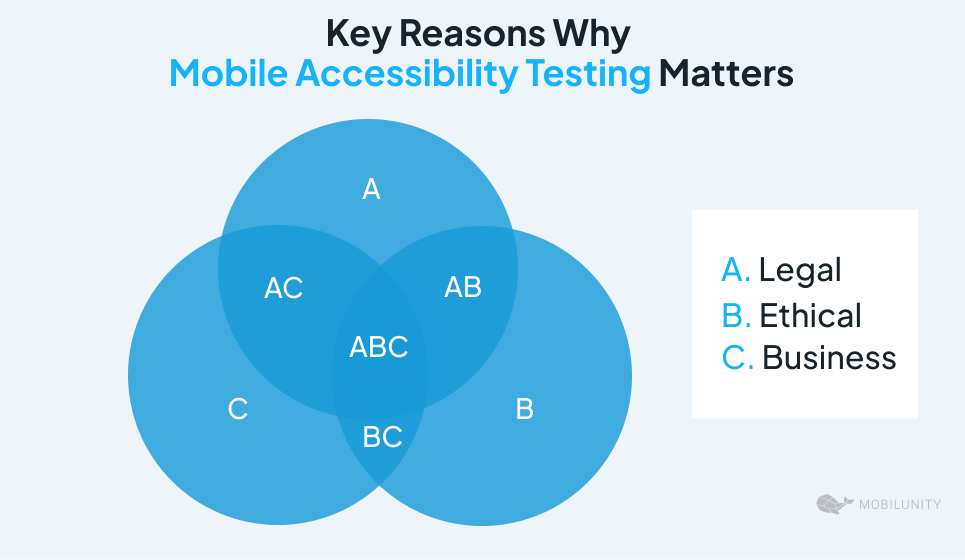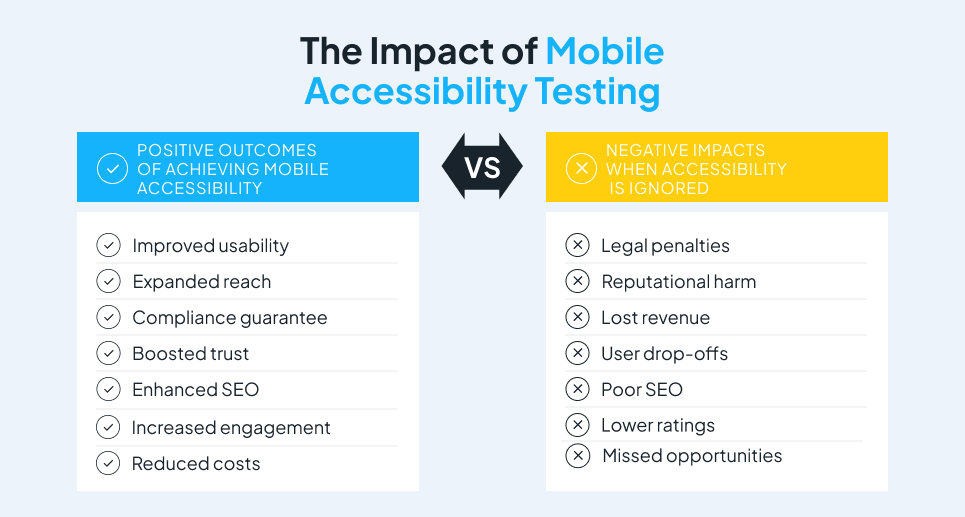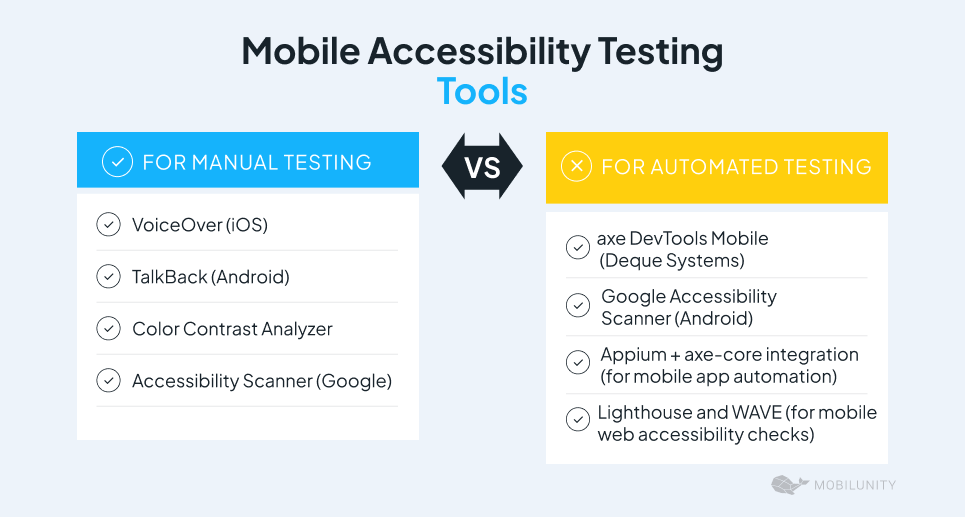Why Mobile Accessibility Testing Is Essential for Your App or Website
- Introduction
- Accessibility Testing For Mobile Apps: Why It Matters
- Benefits of Meeting Mobile Accessibility Compliance
- Common Issues to Look Out for in Mobile Application Accessibility Audit (And How to Fix Them)
- Types of Mobile App Accessibility Testing
- Final Thoughts
- FAQs on Mobile WCAG Compliance Essentials
Introduction
Mobile devices have become the primary gateway to the digital world. No wonder the attention to mobile user experience is rising exponentially, and so are user expectations for accessible and inclusive design.
In particular, according to stats, there are the following mobile-first user experience shifts:
- Mobile accounts for over 62% of global web traffic, with this growing steadily;
- Users (especially teens) now spend around 4.8 hours per day on mobile apps on average;
- M-commerce sales take over a substantial part of business revenue, accounting for 44.6% of total retail ecommerce in the US.
However, despite these realities, far too many businesses haven’t tackled mobile accessibility yet, and undeservedly so. Consumer and regulatory shifts continuously drive further focus on this area, making mobile accessibility not just a nice-to-have feature but an absolute requirement for any modern business.
In this article, we’ll explore the must-know aspects of mobile application accessibility testing. Backed by Mobilunity expertise, we’ll cover all the essentials: what such businesses are missing out on, how to tackle accessibility testing effectively, and more. So, let’s dive in.
What is Mobile Accessibility Testing?
Starting off with the basics, the goal of mobile accessibility is ensure that an app or mobile website can be effectively used by people with disabilities.
Commonly, this testing process incorporates a range of checks. First and foremost, they are centered around evaluating the app’s compliance with recognized global accessibility standards (such as WCAG 2.2 Mobile Accessibility Guidelines and Section 508 compliance for mobile apps).
Overall, mobile accessibility testers look for these issues:
- Missing or incorrect screen reader labels (ARIA tags);
- Poor color contrast that affects readability;
- Small touch targets that are hard to tap;
- Missing alt text for images and icons;
- Disordered focus navigation or broken tab order.
Another important aspect is verifying compatibility with assistive tech solutions. For instance, VoiceOver accessibility testing helps ensure compliance for iOS apps. Similarly, TalkBack accessibility testing guarantees following the recommended guidelines for Android.
Accessibility Testing For Mobile Apps: Why It Matters
Mobile accessibility should be under a close scrutiny for businesses due to a variety of important reasons. Conducting detailed mobile accessibility audits ensures that potential barriers are identified and addressed early. Let’s take a closer look at them.
First and foremost, there are legal considerations that are closely tied to mobile accessibility. Laws and regulations like ADA compliance for mobile apps, Section 508, and the European Accessibility Act all mandate inclusive digital access across all digital solutions, including mobile apps. Non-compliance, in turn, leads to lawsuits, hefty fines, and other negative effects that ruin brand reputation.
Next, there are inclusivity and ethical considerations, both of which are becoming increasingly important to consumers and, in particular, potential brand ambassadors. In the end, it’s not about mere accessibility – for businesses, it’s a strong statement of equal access for all, empathy, and fairness reflected as one of the core business values.
Besides, above all, accessibility impacts a range of business-related benefits, both in direct and indirect ways. See the table below featuring the main ones.
Benefits of Meeting Mobile Accessibility Compliance
Diving into some of the most substantial benefits, these areas are undenied advantages of mobile accessibility compliance.
Expanded Audience Reach
By becoming accessible, your business opens your app to over 1.3 billion people with disabilities and aging users worldwide. This can be a powerful revenue booster and a foundation for the entirely new segment of loyal audience that feels their needs are cared for.
Business Growth & Competitive Edge
Importantly, accessibility can become a strong differentiator. The reason to it is quite straightforward: in many industries, inclusive design is still underutilized. This means accessible apps can stand out, attract new users, and strengthen customer loyalty equally to any other business strategy.
Performance and Excellence
Accessible apps are not just fairer. Since they are built on cleaner code, accessibility-compliant apps perform better, load faster, and overall offer smoother experiences for users. Besides, accessibility best practices like semantic structure, optimized visuals, and responsive design contribute to it, too.
Improved User Experience
Features that enhance accessibility don’t just solely benefit users with disabilities. As a matter of fact, they improve the overall user experience for all users. Here’s how:
- Clear layouts help users quickly locate information and eliminate UX/UI confusion;
- Readable text improves comprehension for all, thus leading to higher engagement or better conversion;
- Intuitive navigation allows faster and smoother interactions;
- Consistent design patterns make interfaces more intuitive and, thus, easier to use.
Non-Compliance Risk Reduction
Compliance with accessibility laws reduces the chances of costly lawsuits. But don’t take our word for it. See recent real-life case of H&R Block, who had to pay $100,000 in damages for non-compliance of its mobile app and website.
Besides, consider the reputation factor. Accessibility lawsuits can lead to public criticism and diminished customer trust, which in turn, directly impacts the company’s revenue and growth.
Common Issues to Look Out for in Mobile Application Accessibility Audit (And How to Fix Them)
While accessibility gaps often go unnoticed during development, they can significantly affect usability and engagement. Explore some of the most commonly overlooked accessibility issues and the ways to solve them in the checklist below.
| Mobile Accessibility Checklist: Tackling Most Common Issues | |
|---|---|
| Screen Reader Incompatibility |
|
| Poor Color Contrast |
|
| Tiny Touch Targets |
|
| Missing Alt Text |
|
| Disordered Focus Navigation |
|
| Gesture-Dependent Controls |
|
| Dynamic Content Not Announced |
|
| Inaccessible Forms |
|
| Overuse of Motion / Animation |
|
| Non-Resizable Text |
|
Types of Mobile App Accessibility Testing
Manual Testing
Manual mobile accessibility audit involves human testers (either seasoned accessibility specialists or people with actual disabilities). These testers aim at evaluating how real people interact with a mobile app on different devices and operating systems.
During the manual testing process, testers perform accessibility checks using various mobile assistive technologies: VoiceOver or iOS, TalkBack for Android, switch controls, magnifiers, and voice commands, to name a few.
In doing so, manual testing commonly incorporates the following areas:
- Screen reader compatibility. Ensuring buttons, icons, and images have proper text alternatives;
- Focus order and navigation, logical movement through screens using touch and assistive navigation;
- Color contrast and readability, with consideration of various screen sizes and lighting conditions;
- Touch targets and gestures, double-checking they are both large enough and have accessible alternatives;
- Dynamic content updates and their efficient preview on screen readers.
| Automated Mobile Accessibility Testing: Key Considerations | |
|---|---|
| Benefits | Limitations |
|
|
Automated Testing
Automated accessibility testing implies the use of software tools that scan apps and mobile websites for accessibility violations.
These tools prove efficiency by accessibility checks at scale. By applying rules from the Web Content Accessibility Guidelines and platform-specific accessibility frameworks, they are able to detect technical issues quickly with a certain level of accuracy.
What automated testing checks:
- Missing alt text or labels for images, buttons, and icons;
- Incorrect or missing ARIA attributes and accessibility identifiers;
- Low color contrast ratios affecting readability;
- Keyboard or focus traps that prevent smooth navigation with assistive devices;
- Improper or missing semantic structure in mobile UI components.
When opting for automated testing, consider this: such testing automation performs best when closely integrated into the development and CI/CD pipeline. This way, it can not only help teams find and fix issues early but also ensure ongoing accessibility compliance.
| Automated Mobile Accessibility Testing: Key Considerations | |
|---|---|
| Benefits | Limitations |
|
|
Best Practice of Mobile Accessibility Assessment: Combine Both Testing Types
As seen, both manual and automated testing have their advantages and drawbacks. Naturally, the most effective approach for mobile apps is a hybrid testing strategy, such as:
- Using automated testing to catch technical accessibility violations early in development;
- Applying manual testing to evaluate user experience, navigation flow, and assistive technology behavior on real devices.
In many cases, accessibility testing for mobile apps can be highly nuanced and requires in-depth expertise in accessibility best practices. A good practice in this case would be to hire mobile application developers with dedicated accessibility testing knowledge. This way, you can ensure you get it right from the very beginning of your app’s creation.
Final Thoughts
By integrating mobile accessibility checks and ADA mobile accessibility audit guidelines into every stage of development, organizations can unlock numerous benefits, from legal risk reduction to higher revenue from improved user experience and beyond.
Ultimately, mobile accessibility is all about much more than compliance. Most importantly, it empowers building digital experiences that include everyone. And, needless to say, that strategy has already proven to pay off for businesses that have embraced it.
FAQs on Mobile WCAG Compliance Essentials
Disclaimer: All salaries and prices mentioned within the article are approximate numbers based on the research done by our in-house Marketing Research Team. Please use these numbers as a reference for comparison only. Feel free to use the contact form to inquire on the specific cost of the talent according to your vacancy requirements and chosen model of engagement.
















